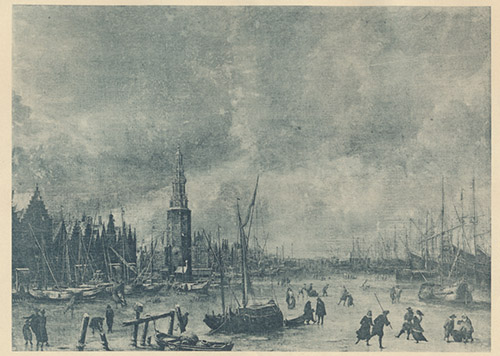
L.O. Smith’s art collection – historical romanticism and classical art
Smith liked to surround himself with art and antiques. He was particularly fond of classical Italian art and the historical paintings of his time.
L.O. Smith, known as “the king of vodka”, had a modest upbringing. Over time, however, he acquired enough capital for an elegant apartment. Located at Blasieholmen in central Stockholm, the apartment was situated in a grand building known as “the Bolinderska Palace”. Photographs reveal that the interior matched the spirit of the time. In Sweden, the style is known as Oskariansk and can be described as a Scandinavian version of the Victorian ideals. The ceiling and walls were lavishly decorated and complemented with heavy drapes and upholstered furniture.
Smith was a sporadic art collector who liked to surround himself with paintings, ornaments and antiques. Two dominating themes in 19th century art were history and romantic nationalism, and Smith was particularly fond of historical paintings and classical Italian art.
Following Smith’s failed Spanish export attempt and his subsequent bankruptcy, the apartment lease was dissolved in 1891 and his possessions were dispersed. It is only thanks to an auction catalog from May the same year that it has been possible to find out which art objects Smith had in the apartment.
Smith’s collection included works by Italian and Dutch masters, among them a harbor view by the landscape painter Beerstraaten. Some paintings bore the signatures of Raphael, Rubens and Tintoretto, but they were well-made copies rather than original works. One dramatic motif showed Attila, the king of the Huns, and his troops as they were stopped from attacking Rome. The painting has been described as “an old and particularly well-made copy” by Raphael. There were also a number of landscape, hunting and religious paintings by unknown artists, and a copy of Rubens’ “The Drunken Silenus” probably amused Smith’s circle of friends.

The collection also included a few Swedish paintings, for example two works by Marcus Larson: ”Landscape with Waterfall” from 1851 and ”Ocean at Night with Burning Ship” from 1858. Both were typical of Larson’s style. He often portrayed man’s vulnerability before the forces of nature. It was a kind of romantic horror, enhanced by elements such as flames and fire, heavy storms, roaring water and the pale moon.
Several paintings in Smith’s apartment had such contemporary themes. One of the most well-known was Johan Gustaf Sandberg’s “Gustav Vasa Speaks to the Dalecarlians at Mora” from 1836. King Gustav Vasa reigned in the 16th century and is known in Sweden as “the father of the nation”. Smith’s oil painting has an interesting history. In 1827, the artist Sandberg had the honor of decorating the church choir in Uppsala Cathedral with a series of frescoes with motifs from Gustav Vasa’s life. To make them as realistic as possible, he studied Renaissance clothing and interior design carefully.
Sandberg created the limestone paintings between 1833 and 1838. Later, he made easel paintings based on the frescoes. One of these – the one that shows king Gustav Vasa addressing a group of men at Mora – was included in L.O. Smith’s art collection. Today, the painting can be found in the National Museum in Stockholm.
Famous and unknown female artists
There were also several female artists in Smith’s art collection, for example Jenny Nyström and the fairly unknown Virginia Larson. After losing her hearing in her twenties, Larson found a way to express herself through art. She studied at Stockholm’s Academy of Fine Arts between 1865 and 1869. Later in life, she spent five years in Rome. It seems that Larson had no interest in fame and when she passed away in 1893, she was relatively unknown. She left behind a rich production of landscape and portrait paintings.
Two objects in Smith’s apartment deserve special attention: The huge twelve-arm chandeliers. These magnificent crystal objects came from the art collections at Tidö Castle. Another splendid piece of furniture was a precious 18th-century table from France. Covered with porcelain from Sèvre, the table had once belonged to Napoleon III. The table top was divided in sections with portraits of famous people, among them the distinguished Swedish botanist Carl Linnaeus (also known as Carl von Linné). The auction also included marble statues by sculptors Bengt Erland Fogelberg and Johan Niclas Byström.
The total bid price at the auction amounted to 71,000 SEK, which was probably a fraction of what Smith had paid for his collection. He was later able to buy back some of the items, for example the precious French table.
Today, the apartment is part of the banquet hall at Stockholm’s Grand Hôtel. The special atmosphere from L.O. Smith’s days is partly preserved, for example through a number of magnificent ceiling paintings. These mythological motifs were the creation of several people, including the artist Mårten Winge, who was also Professor at the Academy of Fine Arts. One of Winge’s most famous works is the monumental painting ”Thor’s Fight with the Giants” from 1872. It was bought by king Charles XV and later donated to the National Museum.
The ceiling paintings were later completed by a younger generation of artists, including the then unknown Carl Larsson. Perhaps the paintings brought a smile to Smith’s face as he stopped to ponder their motifs, recognizing in them his own battles in life.